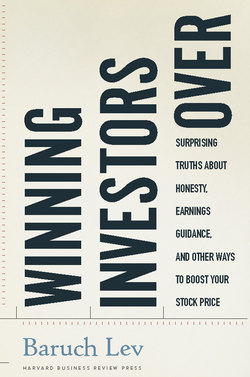Читать книгу Winning Investors Over - Baruch Lev - Страница 19
На сайте Литреса книга снята с продажи.
Speak Softly and Carry a Big (Hard) Stick
ОглавлениеInvestors' limited attention and constrained cognitive capacity naturally sway them toward hard information, which is easily reduced to numbers and thereby made salient, and away from soft information, which is hard to summarize by a quantitative score.17 Moreover, institutional investors—investment managers, banks, insurance companies—prefer hard information, like earnings or sales, because it is easy to transmit across their hierarchies to researchers and investment managers and will be interpreted uniformly by the various employees and executives on the decision-making team. Soft information, such as a description of the competitive position of the company or the strength of its intellectual property, may be lost in translation across hierarchical channels. Soft information is also easier to hype and misinterpret relative to hard data. And yet, soft information or narrative is extensive in managerial communications, such as earnings press releases and conference calls, and is potentially very useful. So, what is the impact of soft information on investors and how can you enhance this impact?
As Mitchell Petersen points out, there is more to the distinction between hard and soft information than numeric versus narrative (text).18 After all, any soft information, like a discussion of the company's competitive position, can be transformed to a numeric score, say, on a one-to-ten scale, based on the receiver's assessment. The main difference between hard and soft information lies elsewhere. Truly hard information is uniform—has the same meaning to different persons—like a company's annual sales number, whereas soft information, like the subjective scores of customer or employee satisfaction, is rarely uniform and will be interpreted differently by different people. The reason is that “with soft information the context under which it is collected and the collector of the information are part of the information.”19 This “information baggage” (context and collector) limits significantly the usefulness of soft information and the ability to delegate decisions based on soft information (one collects, another decides, a third oversees execution). To fully appreciate a customer satisfaction or a social responsibility score, you need to know how and by whom the underlying surveys were conducted. Hard information, on the other hand, like a company's earnings or liabilities, can be interpreted without context or knowledge of the collector.
Another important advantage of hard information, particularly a forward-looking one, is its verifiability. A management forecast of 25 percent gross margin next year can be easily compared later on with the actual gross margin, whereas a soft statement such as, “We remain confident that AOL is on the right track,”20 is largely unverifiable. The verifiability of a message effectively disciplines and keeps the communicator honest, mitigating manipulation and hype, thereby enhancing the credibility of the message. Effective communication strategy should therefore strive to harden soft information as far as possible, such as the use of an industry-standardized methodology for measuring the all-important book-to-bill ratio (order backlog in the semiconductor industry) and the use of a common data collector (a major accounting firm) for this indicator, disposing of the need to specify the context (methodology) and the collector of the information in each book-to-bill communication. Or, accompanying a reassurance such as, “the company is on the right track,” with measurable and verifiable milestones, such as an expected 12 percent return on equity next year. Hardening soft information is critical to effective communication.
Hard information is not a panacea, however. In the process of transforming soft to hard information, certain valuable knowledge is lost, adversely affecting decisions based on the information.21 And when decisions are entirely based on hard data, it's easy to distort them by manipulating the information. Thus, for example, when the creditworthiness of a loan or credit card applicant is solely determined by a hard, numeric score based on several attributes (e.g., income, age, place of residence), considerable relevant information, such as the applicant's wealth, family resources, or social network, is lost. And when some of the attributes of the score are known to applicants, they can easily misrepresent them (e.g., claim a higher income, say, as was frequently done during the mortgage boom preceding the 2007 to 2008 subprime debacle). The choice, therefore, is not between hard or soft information, but rather finding the right combination of hard and hardened soft information.22
The important role that soft information plays in investors' decisions is evidenced by the startling finding that the key, hard corporate data—earnings and book values (net assets)—account statistically for no more than 10 percent of stock price changes around the financial report release.23 Clearly, the soft information conveyed in the financial report (in the management, discussion, and analysis section, for example), as well as in managers' press releases and conference calls, drives many investors' decisions. The key issue for managers then is how to effectively communicate soft information to investors suffering from limited attention and constrained information-processing capacity. Let's start with the ubiquitous earnings conference call.
